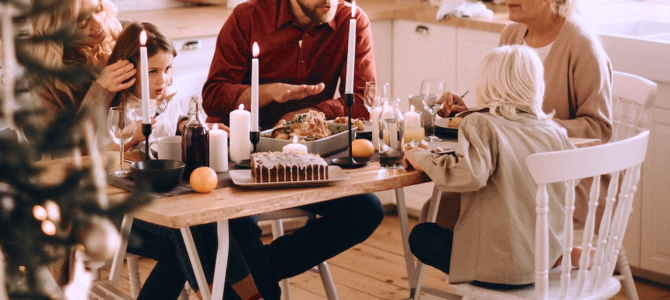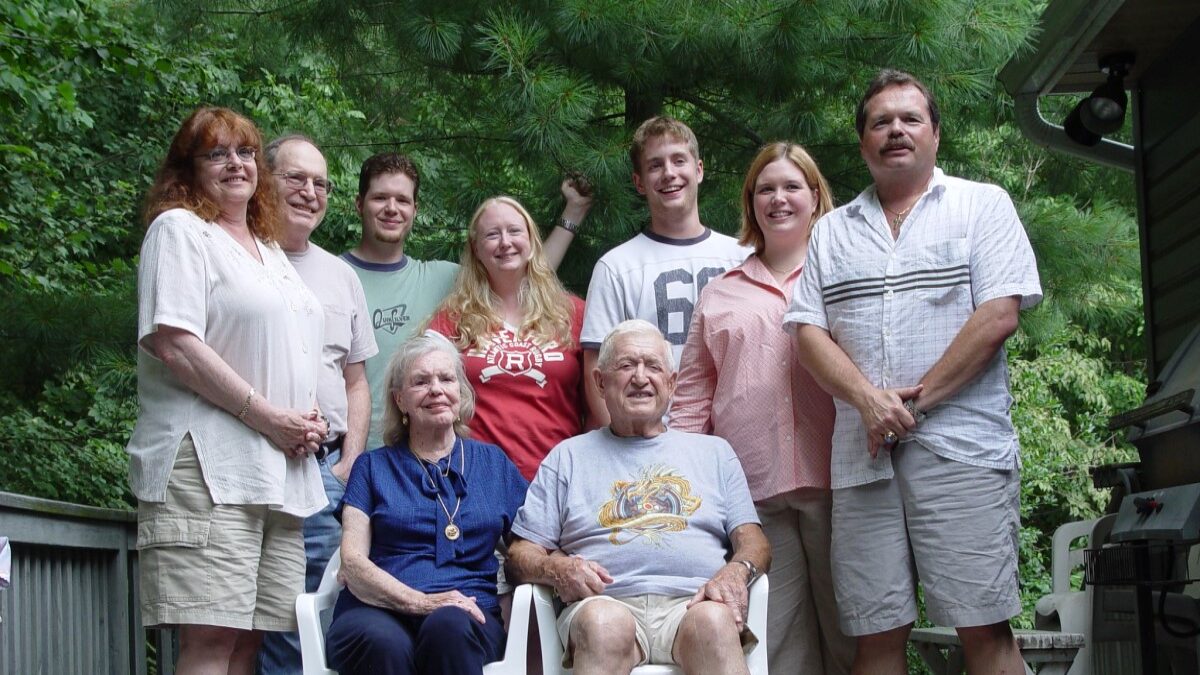
I love my extended family. David Brooks, not so much. His way of writing about the decline of the American extended family is occasionally hysterical, sometimes saccharine, and entirely lacking perspective. The suggestion that the nuclear family was a mistake strikes this immigrant as un-American.
Brooks uses the 1990 movie “Avalon” as a metaphor for family fracture. In the beginning, we see a large group of kinfolk at a holiday dinner:
As the years go by in the movie, the extended family plays a smaller and smaller role. By the 1960s, there’s no extended family at Thanksgiving. It’s just a young father and mother and their son and daughter, eating turkey off trays in front of the television. In the final scene, the main character is living alone in a nursing home, wondering what happened.
Thus, nuclear family is a station on the way from the tribal “tangled, loving, exhausting glory” to total loneliness.
It’s a flawed, overly dramatic setup because, while it’s the norm for today’s nuclear families to live apart from cousins and grandmas, everyone still gets invited to Thanksgiving dinners. Multigenerational gatherings are so much the cultural expectation that pundits advise starting political arguments around the holiday table: See what happens if the crazy uncle chimes in.
Is the Nuclear Family an Anomaly?
Brooks explains that, prior to industrialization, most Americans lived on farms and worked together within corporate family arrangements. Distant relatives filled in for each other, taking care of the young and the old, smoothing out intra-family feuds.
Brooks tends to overly idealize the extended family, which is not exactly primitive communism where leadership emerges spontaneously and everyone contributes according to his ability and takes according to his need. Clans operate with a clear chain of command, and that chain is not matrilineal. Some family members often end up feeling cheated or alienated, so rivalries abound.
Brooks sees the nuclear family as an anomaly fashioned in the Victorian era and fully realized in the 1950s. Even then, it only existed for about a dozen years and solely because of unique historical circumstances — namely, unions enabled men to find good-paying jobs, women were excluded from the workforce for child-rearing, and a high degree of social trust meant families in geographic proximity could forge tribal bonds.
With its focus on the last 250 years, Brooks’ narrative overlooks the fact that the extreme nuclear family — mom, dad, and minor children living in a single household — has been the Anglo-Saxon ideal since time immemorial. In “America 3.0,” James C. Bennett and Michael J. Lotus note that Germanic tribes on the outskirts of the Roman Empire lived in dwellings that resembled today’s single-family suburban households. These tribes eventually took over the British Isles, and their descendants have spread across the American continent.
Young families were always expected to move out as soon as land became available. Only economic pressure kept children under the same roof as their parents — not unlike what student loans are doing today. In Bennett and Lotus’s model, the success of the post-war extreme nuclear family is not a step on the way to total disintegration, but a contemporary realization of the age-old dream.
Brooks notes that economically stressed immigrant families are more likely to live in multigenerational households. Coming from an upwardly mobile immigrant subculture, I can assure you something more significant than economic pressure keeps multiple generations under the same roof: tradition. Bennett and Lotus argue that as immigrants assimilate, they adopt the kinship model of their American neighbors. The extreme nuclear family is a building block of a dynamic, mobile capitalist society — our past, present, and future.
What Brooks Doesn’t Get About Community
Brooks would agree with the point about dynamism, but would ask: “At what cost?” The fracture of the “fragile” nuclear family has been debilitating for the lower classes. He chides conservatives for incessantly telling the poor to build stable nuclear families — a pointless undertaking, in his opinion. If he knows conservatives so well, he should perhaps acknowledge that we offer different explanations for the decline.
Where the author sees unions as benign enablers of the short-lived blossoming of patriarchal nuclear families, conservatives argue that the greedy labor establishment destroyed American industry and point out that the working class in right-to-work states is doing fine. Moreover, capitalism isn’t eating into the family. Rather, that’s what welfare state is doing, providing mothers subsidies that enable fatherless child-rearing.
Our lawmakers in all levels of government are putting in place an elaborate set of workplace arrangements that will make it costly for a young mother to disentangle herself from full-time employment to raise children. That said, many conservatives more or less align with Brooks’s idea that societal trust is evaporating, or that we are perhaps too individualistic.
Brooks acknowledges that extended family can be excruciating and repressive. He blames it on the fact that people don’t choose their kin. He then suggests replacing the allegedly failed nuclear family with “families of choice,” which is a dramatic way of saying “friends.” He rounds up anthropological evidence:
The Chuukese people in Micronesia have a saying: ‘My sibling from the same canoe’; if two people survive a dangerous trial at sea, then they become kin. On the Alaskan North Slope, the Inupiat name their children after dead people, and those children are considered members of their namesake’s family.
The first study sounds like a description of a rite-of-passage ritual, or a trial not unlike what young Americans do in fraternities or the Armed Forces, and the second practice is a bit like having godparents or namesakes. Fraternity brothers and soldiers bond and live together for a while until they age out of the communal arrangements. Their close camaraderie is a stage in life following childhood and preceding marriage.
Brooks sees youthful adventure as a foundation of permanent living arrangements. He gives the example of Temescal Commons in Oakland, California, as a functioning, chosen extended family mysteriously bound into a tight-knit community:
[T]he 23 members, ranging in age from 1 to 83, live in a complex with nine housing units. This is not some rich Bay Area hipster commune. The apartments are small, and the residents are middle- and working-class. They have a shared courtyard and a shared industrial-size kitchen where residents prepare a communal dinner on Thursday and Sunday nights. Upkeep is a shared responsibility. The adults babysit one another’s children, and members borrow sugar and milk from one another. The older parents counsel the younger ones. When members of this extended family have suffered bouts of unemployment or major health crises, the whole clan has rallied together.
So, like a dorm, but for life. As a descendent of people who at some point were all crammed into Soviet communal apartments, or kommunalki, I find the description above hopelessly naïve.
Communal Living Isn’t Romantic
Brooks is not the only pundit who has been romanticizing communal living, especially communal kitchens. In a bizarro segment, National Public Radio lauded Soviet communal kitchens for allegedly fostering anti-Stalinist resistance. In reality, those were a constant source of irritation and discontent: the worry about broken dishes, stolen food, noisy drunks, and, during Stalin’s Reign of Terror, the numbing fear that the neighbors may turn to the NKVD to evict an odd tenant to the Gulags.
There was little trust in kommunalki, but plenty of fear and resentment. The 1950s suburbs with high trust and lots of privacy, and where every woman was the mistress of her own kitchen, were the polar opposite of Soviet communal apartments.
Wealthy Americans such as Brooks tend to romanticize food and rituals surrounding it, and this is a mistake. Like living in close proximity does not ensure trust, and scheduling people to break bread with each other is an unnatural way to form meaningful relationships.
Cooking with others and for large groups of people is nerve-racking. Brooks mentions a study showing that women working in extended family kitchens tend to have higher rates of heart diseases because of the stress of cooking for a large brood. Imagine cooking for two dozen non-relatives while sharing the kitchen with random neighbors!
A Co-op Can’t Replace the Nuclear Family
Actually, none of it should be too hard to imagine. Because young Americans typically leave their parents and spend several years living with roommates, we all have a kind of window to the lifelong communal misery. In the short term, hanging out together and meeting new people is fun. Yet once romantic relationships are forged, roommates move out. To move back to a communal arrangement at the point in one’s life when the habits have already formed is an odd sort of midlife crisis.
The reason extended clans work is that individuals don’t chose them. They are bound together by bloodlines for which there are no substitutes. Friendships are optional, and if they go astray or buddies grow apart, there is no shame in breaking them off, or at least stopping friendship maintenance. Glorified roommates are not displacing families because the former are not nearly as reliable.
Nuclear families are not fragile, but friendships are a poor substitute for tribes and families. A co-op may sound better than total isolation, but to spend one’s entire life in one is still a lonely proposition.
The erosion of trust Brooks notes is not going to be countered by arranging diverse families in crypto-socialist dwellings where they are forced to share amenities. That’s a miserable life, and it’s not in our cultural DNA. A better option is to free men and women to form stable nuclear families, have many children, and then organize communities around family needs. Yes, rebuild nuclear families.









